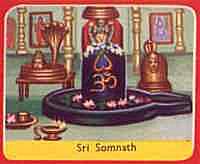Jyotirlinga Sthalams
Somanath Temple

Somanath is
situated in the south coast of Saurashtra, near Veraval in Gujarat. The
original temple structure had been destroyed several times by attack of
invaders. The great freedom fighter, Sardar Vallabhai Patel, played a vital
role in the renovation of the temple & there is a sculpture of Sardar
Patel at the entrance to the temple.
The temple
was once upon a time decorated with gold and silver, but was all looted
by invaders. But the temple that remains in stone is still a splendorous
beauty.
Sthapathis
from various parts of India played a role in the renovation process, revealing
their skills, adding to the sculptural glory of the temple. The lord
here is called Somanathar and Someshwar. This Siva Lingam that was
formed spontaneously is one among the 12 Jothirlingams. The tank,
where Chandra Bhagavan took his holy dips during penance is called Somagundam.
Chandra Devan
worshipped Siva at this spot to rid himself of the curse of Daksha.
The legend:
Chandra Devan
is considered to have built this temple & hence the name Somanathar
to the Lord. Chandran fell in love with Rohini, one of the daughters
of Dakshan. But Dakshan wanted to give all his daughters in marraige
to one able & loving person, who would treat all his daughters equally.
Chandran got
married to all, but his love for Rohini was too great & the other daughters
complained to their father. Dakshan cursed Chandran to dwindle in
power & beauty. When Chandran begged forgiveness, Dakshan
said that only prayers to Lord Siva, could free him of the curse.
Chandran came to Somanath & prayed to Lord Siva, doing penance for
about 4,000 years. Lord Siva appeared & said that he could not
fully absolve him of the curse. Instead, he would wane in 15 days,
but would grow again. This is the story said for the waxing &
waning of the moon, producing new moon & full moon.
This temple
had been demolished and reconstructed several times. It was reconstructed
in 649 A.D and again in 722 A.D. From 750A.D - 950 A.D, the temple
was well maintained by the Chalukya rulers, after the destruction by Mahmud
of Ghazini. During this period the dome & sthupi were laid in
gold. Once again, the temple was destroyed by Allaudin in 1296 A.D.
The Khengars who ruled from 1325 - 1351, took up the restoration work.
It was later destroyed again by Aurangazeb. It was reconstructed
at a slightly different spot by Ahalya Bai & was later well maintained
by the Baroda rulers. After Independence, a committe was appointed
to reconstruct in the original spot & Sardar Patel played a major role
in this reconstruction.